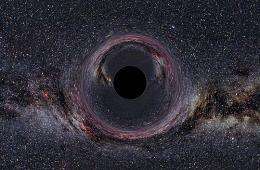An artist's impression of a Super Massive Black Hole.
A University of Sydney researcher was part of an international team of astronomers that has observed an incredibly rare event that occurs once every 10,000 years per galaxy.
The astronomers saw a star that had strayed too close to a super massive black hole being literally torn apart. The Australian, Dr. Sean Farrell, an ARC post-doctoral fellow in the School of Physics, said the observation was first made in 2006 through the European Space Agency's X-ray Telescope, XMM-Newton.
The astronomers were researching archival data when they noticed the bright flare, which they realised was the signature of a star being ripped apart in a galaxy 500 million light years away.
The star, initially detected in 2006 by Dr. Dacheng Lin, who led the study, was observed again in 2007, by which time it had increased in brightness. Dr. Lin researched data from 1992, which showed there was no trace on any X-ray source dating back to that time.
In February 2011, using NASA's SWIFT X-ray Telescope, Lin observed the area again and found the flare had dimmed significantly. It was then that the international collaborators knew they had witnessed something truly astonishing.
"Dr. Lin's research raised the possibility that we had indeed stumbled onto a very rare extreme event," says Dr Farrell. "We were very lucky that the telescope happened to have this event in its field of view.
"Of course when we realized that the star had been obliterated because it had gone too close to a super massive black hole we knew what we had observed was something even more extraordinary."
Super massive black holes (SMBH) have been theoretically predicted by theories Einstein wrote in 1915, but little is known about them. "We know that they exist in the middle of galaxies and have three known traits: mass, spin and charge.
"The first two of these can be measured but the third cannot. We do know if something goes into a SMBH it will never be seen again," says Dr. Farrell. "So to have witnessed such a rare event provides us with an incredible opportunity to study what happens to stars when they get too close to the edge of a SMBH."
Dr. Farrell says that these observations will be important for testing theories on gravity as well as helping us understand how SMBH grow or 'feed'. "Black holes are crucial in how galaxies form and evolve. This is very important as their influence on galaxies has an enormous effect on gas, stars, planets, and, of course, life itself," Dr. Farrell explains.
"By studying the boundaries of black holes we can gain crucial knowledge about these extreme objects and their impact in the universe."
The team's paper, titled 'Discovery of an ultrasoft X-ray transient source in the 2XMM catalog: a tidal disruption event candidate', will be published in the Astrophysics Journal.
Provided by University of Sydney
























